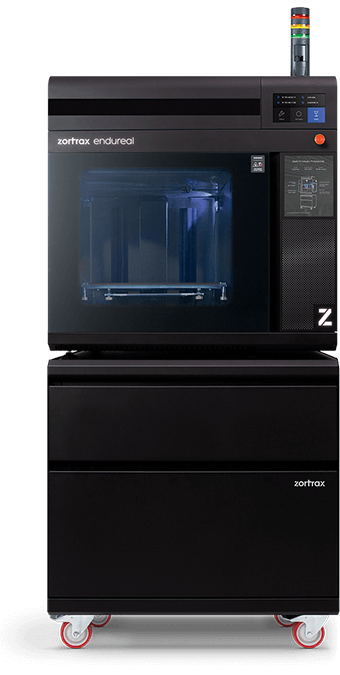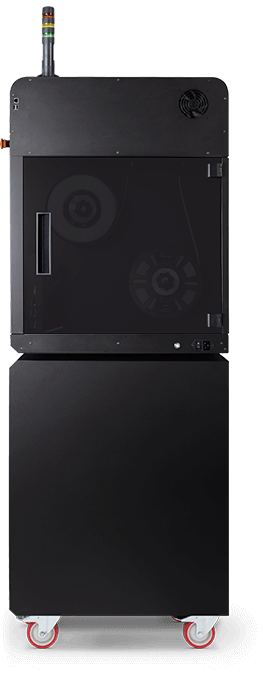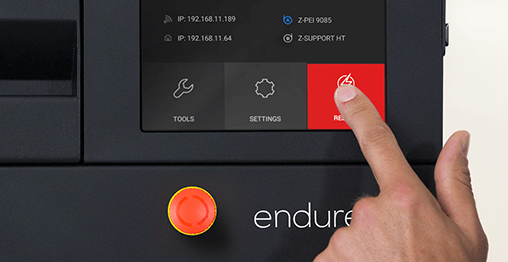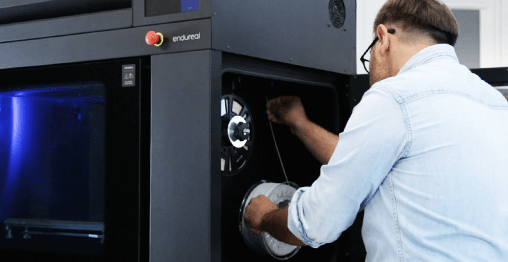Blackout Response System
When a power outage is detected, Endureal uses the energy stored in built-in capacitors to save the exact position of the printing head. This way printing can be resumed from the same spot when the power is back on.
Advanced thermal management enabling efficient work with high-performance polymers is what third generation 3D printers are all about, according to the industry’s thought leaders. Temperature of filaments in Zortrax Endureal LPD Plus 3D printer is tightly controlled at each stage of processing to achieve utmost precision and best possible mechanical properties of 3D printed parts.
An advanced extruder can work at sustained temperatures as high as 480 °C to support processing demanding filaments.
Temperature in the printing chamber can reach up to 200 °C to ensure best thermal conditions for high-temperature materials.
A build-platform supporting temperatures of up to 220 °C to ensure appropriate stability to models.



Thermally shielded extruder's compartment is always kept at low temperatures to ensure uninterrupted filament transmission.
Filaments are stored in a secure, closed environment at temperature optimal for both high performance and standard polymers the Endureal is designed to work with.
Key components in the Zortrax Endureal have been designed to be easily maintained and fixed on the spot without voiding the warranty with the use of tools and parts provided in the Maintenance Kit.

Zortrax Endureal has over 30 built-in sensors working in real-time to guarantee seamless operation in high-tech manufacturing and product development projects.

When a power outage is detected, Endureal uses the energy stored in built-in capacitors to save the exact position of the printing head. This way printing can be resumed from the same spot when the power is back on.

Printing progress can be monitored remotely with a heat-resistant camera installed in the Endureal's printing chamber. The camera is capable of live video streaming and designed to work in demanding conditions.

Separate sensors work at all times to detect events when filament is jammed or depleted. The printer also monitors the weight of the filament spools to determine if there is enough material to complete the printing process.

Filaments’ compartment creates an optimal environment for storing material spools. It is equipped with a moisture absorber which is responsible for reducing humidity to levels appropriate for highly hygroscopic materials.
A wide array of sensors ensure that the Zortrax Endureal always delivers best possible performance.
Build volume measuring 400 x 300 x 300 mm is large enough to accommodate full-sized structural industrial components. Due to soluble support printing capability, most of the build volume can be used by stacking models in batches arranged on top of the other.



The Endureal has an advanced dual-extrusion system capable of printing high-performance and metallic filaments with dedicated support materials. The extruder components and cables are thermally shielded from the main chamber with an elastic, nanoporous insulator to achieve the lowest possible thermal conductivity. Nozzles made with a special kind of industrial bronze makes it possible to work even with highly abrasive materials. The Endureal is therefore capable of processing polymers such as Z-PEEK, VICTREX AM™ 200, Z-PEI 9085 or Z-PEI 1010, and Forward AM Ultrafuse® metallic powder filaments used for making fully functional steel parts. The printer supports both single- and dual-extrusion modes.
The Endureal is equipped with an aluminum build platform covered with a PEI plate to ensure proper adhesion of high-performance polymers. The platform can be heated up to 220° C.
Wide range of materials supported by Zortrax Endureal makes it possible to go from early low-cost prototypes to the final high-performing part using one manufacturing device.
Zortrax products, the Endureal included, can work together in highly scalable, modular systems. While the Endureal's main purpose is printing critical components out of very advanced materials, the early prototyping tasks can be easily ceded to clusters of low-maintenance desktop 3D printers like the M Series Plus or M300 Dual.
All network-enabled Zortrax 3D printers along with the staff responsible for running them can be remotely managed with Zortrax inCloud 3D printing management service. Professional and Enterprise inCloud subscription plans enable organizing people into teams with assigned 3D printers. Data on how human and 3D printing resources have been employed is aggregated in neatly spaced panels.
A high-performing part is designed in CAD software.

Concept models are printed with low-cost materials.

Post-processing techniques like annealing are applied to achieve target properties of the material.

Concept models are used for preliminary evaluation.
A high-performing part is designed in CAD software.

Concept models are printed with low-cost materials.

Concept models are used for preliminary evaluation.

Post-processing techniques like annealing are applied to achieve target properties of the material.
Zortrax industrial systems are designed in such a way that new devices can be added at all times without incurring additional integration costs. It is possible to quickly install more clusters of cost-efficient M Series machines when an organization needs to increase production volume, more Endureal 3D printers for high-tech applications, or more Apoller devices to expand post-processing capabilities.
A Zortrax industrial system comprising of the Endureal 3D printer supported by a cluster of M Series machines and the Apoller post-processing devices leaves plenty of room for cost-free, on-the-fly adjustments. Even projects that have reached the stage where final parts are printed out of target materials on Endureal 3D printers can be quickly reversed to initial prototyping on M Series machines with a few clicks in Zortrax inCloud.

Being a full-fledged industrial machine, Endureal can be implemented as easily as Zortrax desktop-class 3D devices. Intuitive user interface and software with carefully tuned settings predefined for each dedicated filament make Endureal ready to work at full capacity from day one. The ease of implementation extends further into running the printer due to business continuity kit containing everything necessary for fast and efficient in-house maintenance.
3D print with metal filaments and the strongest polymers on the planet. Request a presentation on Zortrax Endureal.